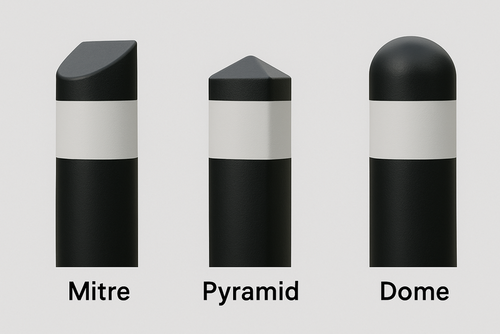Stay up to date with products and offers

Released On 6th Aug 2025
A Comprehensive Guide to Bollards
Bollards are a feature we often overlook, but they play a big role in keeping our roads and public spaces safe. Lining busy high streets, protecting shopfronts or marking cycle lanes, bollards help direct traffic and protect pedestrians and infrastructure. And while their design has come a long way since their origins as mooring posts in the 17th century, they still serve the same important purpose: defining boundaries and providing safety.
In this guide, we’ll cover where bollards are typically used, the different styles and finishes available, how they’re installed and what it takes to keep them in good condition.
The most common applications and uses
- Traffic control: managing vehicle flow, defining road boundaries and preventing unauthorised access in busy areas
- Pedestrian safety: separating pedestrian zones from traffic and guide foot traffic in public spaces
- Security protection: preventing vehicle-based attacks and safeguard high-risk sites like airports, government buildings and financial institutions
- Property protection: shielding storefronts, gas stations, parking garages and other structures from accidental vehicle collisions or reckless driving
- Parking management: used in car parks to define spaces and prevent unauthorised vehicle movement
- Public space design: installed in urban areas, parks, schools and campuses to organise space and improve flow
What types of bollards are available?
Permanent bollards
Permanent bollards are bollards embedded and fixed into the ground. They are most used for high-security areas and ideal for protecting buildings, pedestrian areas and critical infrastructure. Made from stainless steel, concrete or even cast iron, they are highly durable and extremely impact resistant.
Removable bollards
Removable bollards can be easily unlocked and removed when necessary, unlike permanent bollards, allowing for temporary access and reinstalled when security is needed. They work well in areas that occasionally require vehicle access such as event spaces, loading bays, maintenance or emergency zones.
Flexible bollards
Flexible bollards are used in areas with a high expectation of impact and bend upon impact, reducing damage to vehicles while maintaining traffic control. They are suitable for bike lanes, pedestrian crossings and parking lots where vehicle contact is likely.
Bollard finishes and features
- Galvanised finish: bollards for outdoor / external use are often hot-dipped galvanised for long-lasting, rust-resistant protection. This finish is tougher and more weather-resistant than stainless steel or flexible plastic options.
- Powder-coated in RAL 007 yellow: this bold yellow finish improves visibility in high-traffic areas, helping to minimise the risk of accidental bumps or collisions.
- Black banding: creates a sleek, professional appearance that blends well with modern commercial settings.
- Reflective banding: improves visibility in low-light and nighttime conditions, keeping both drivers and pedestrians safe. Bollards like the Berkeley Rubber Bollard include this feature as standard.
- Cap options: choose from flat, mitre, pyramid or dome caps to match the look or purpose of your space.

How are bollards installed?
Bollard installation varies depending on the type and purpose, but generally involves securing the bollard firmly into or onto the ground.
Permanent bollards are typically embedded into deep concrete foundations, making them a long-lasting solution for high-security areas. Removable bollards, on the other hand, use a ground socket securely fixed into concrete below the surface. The bollard fits into this socket and locks in place, allowing it to be easily removed when temporary vehicle access is needed. When not in use, the socket sits flush with the ground, keeping the area safe and unobstructed.
Surface-mounted or shallow-set installations are common for lighter or flexible bollards, which are designed to absorb impact without causing damage. Regardless of the type, proper fixing and spacing in between bollards, is essential for providing maximum protection for pedestrians, vehicles and property.
Maintenance and longevity
To keep bollards safe and effective over time, regular maintenance is key. This means inspecting your bollards frequently for signs of wear, such as cracks in concrete, rust on metal or any damage to plastic components. Maintenance also includes repainting, repairing or replacing any damaged bollards, and checking overall structural integrity. Staying on top of this will help extend the lifespan of your bollards and keep them both functional as well as visually appealing.
Do I need planning permission to install bollards on my property?
In the UK, you may need planning permission to install a bollard, even if you own the building; it depends on where you're installing it and what type of property it is.
Here are the key considerations:
- Private land: planning permission is usually not required if you're installing bollards on land you own, such as your own driveway, provided they are used for security and access control and do not obstruct public access. However, if your property is in a conservation area, you may need consent before making any changes.
- Public property: installing bollards on any part of public land, including pavements in front of your property or footpaths, requires permission from your local council or highway authority. Doing so without proper consent can be an offence under the Highways Act 1980.
- Commercial properties or flats: if your property is leasehold or part of a managed block, e.g. flats or business parks, you’ll need to check with the freeholder or management company before installing anything externally, even on areas that appear private.
- Automatic, retractable or illuminated bollards: bollards with electrical components or rising mechanisms may fall under building regulations or require additional approvals, especially if the work involves wiring, drainage or underground infrastructure.
If you're installing bollards on private land you own, and it's not listed or in a conservation area, you're likely fine without formal planning permission, however, it’s always wise to check with your local council first, just to be sure.
At Fixing & Fittings, we stock a wide range of high-quality bollards in a variety of styles and sizes. For assistance or more information about our products, call us today on 01460 261213 or email us at [email protected].


